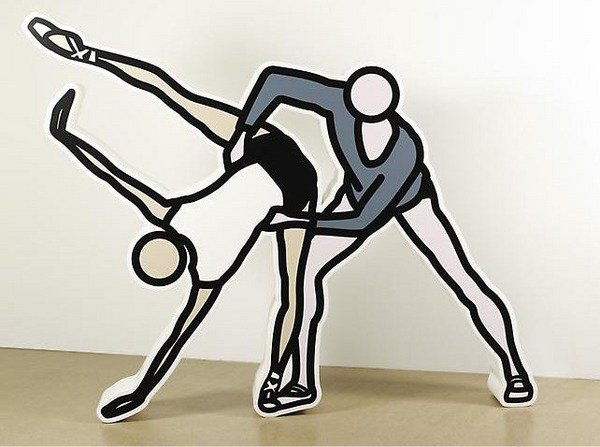Julian Opie
dal 17/11/2011 al 19/1/2012
Segnalato da
17/11/2011
Julian Opie
Lisson Gallery Milan, Milano
Opere recenti. L'artista ricostruisce le sue impressioni sui contorni della contemporaneita' con linguaggio pittorico conciso. La figura umana - mentre cammina, balla, riposa - e' un motivo dominante nel suo lavoro e nella mostra milanese.

Lisson Gallery Milan is delighted to announce an exhibition of recent work by renowned British
artist, Julian Opie.
Julian Opie is one of the most significant artists of his generation. Drawing from influences as
diverse as billboard signs, contemporary dance, classical portraiture and sculpture, and working
in a variety of media, he reconstructs his impressions of our contemporary surroundings in a
concise, pictorial language. Images, memories and sensory experiences from our encounters
with the world are distilled into signs that in turn encourage the spectator to reflect on the
nature of reality. The human figure – walking, dancing, resting, alone or in crowds – is a
dominant motif in Opie’s work and his exhibition in Milan takes this theme as its focus.
In 2009, Opie collaborated with Royal Ballet choreographer, Wayne McGregor, on the
production, Infra, designing a moving LED tableau that provided a backdrop and counterpoint
for the dancers. This collaboration inspired Opie to continue working with trained ballet
dancers. In Ed and Marianela. 9. and Eric and Sarah. 3., Opie presents two pairs of dancers, mid
performance, frozen in time and yet, conversely, full of movement. The aluminium sculpture, Ed
and Marianela. 9., is freestanding and readable from both sides. The spectator is invited to walk
around it, viewing it from different angles; an interaction that in turn echoes its implied
movement. Caterina dancing naked. 11. is comprised of solid cubes of granite composed like
building blocks that allow just enough space for the drawn, naked form to stride across the
surface. The figure imbues the sculpture with a sense of unbridled energy and palpable
movement that belies the solidity and materiality of the stone.
The walking figure is central to Opie’s practice. Echoing the cityscape and referencing the
ubiquitous imagery of street signage, the ‘two dimensional’, monolithic LED sculpture is made up
of pulsing, light emitting diodes delineating a two-dimensional figure that, like a snapshot of a
busy street, walks in an endless and unspecific journey.
While Opie produces works in diverse media including computer animation, LEDs, granite,
aluminium, vinyl and silkscreen, Mary Horlock has emphasized that his focus has always been
drawing, and this is evident in the rigour, immediacy and economy of his line (1). The drawings
he creates are not simply reductive however: starting with the line, Opie provides only the
essentials; a refined purity that gives the spectator just enough information to reformulate and
understand the experience.
The public and performative nature of the more strident, dancing and walking works, is in stark
contrast to the quiet, still intimacy of the two portraits of Aniela: Opie’s wife. The vinyl work,
Aniela disrobed 1., observes the subject at her toilet, in a private moment of undress: the deep
red background intimating the boudoir. The pose, reminiscent of classical statuary, lends the
work a serenity and timelessness. In Aniela at the spring., Opie echoes Botticelli’s The Birth of
Venus, an inescapably classic motif in turn reinforced by the inclusion of an amphora. Unlike the
dancers and walking figure, these works are comparatively modest – Aniela either turns away
from the spectator or attempts to cover her nakedness - and one is reminded of the uniqueness
of Opie’s relationship to this subject. Despite these references to classicism, more usually
associated with the rarified and museological, Opie’s use of the plastic language of ubiquitous,
city signage establishes these works as unequivocally contemporary.
About the Artist
Julian Opie lives and works in London. He studied at Goldsmith’s College of Art, graduating in
1982. He has exhibited extensively internationally and recent important exhibitions and
projects include; DLA Piper Series, Tate Liverpool, UK (2009-12); Julian Opie, IVAM, Valencia,
Spain (2010); Julian Opie, Lisson Gallery, London (2008); Julian Opie, Recent Works, MAK, Vienna
(2008); Walking on the Vltava, Museum Kampa, Prague (2007); Julian & Suzanne walking, a
permanent installation at Phoenix Art Museum (2007); Julian Opie, Signs, City of Indianapolis,
(2006-7); Julian Opie & Henry Moore, Art Gallery of Ontario, Toronto (2006); Julian Opie, Centre
de Arte Contemporáneo de Malaga (2006); Animals, buildings, cars and people, City Hall Park,
New York, organised by the Public Art Fund (2004-5); We swam amongst the fishes, Museum of
Contemporary Art, Chicago (2004); Bijou gets undressed, K21 Kunstsammlung Nordrhein-
Westfalen, Düsseldorf (2003).
Opie will make an exhibition of new work for Lisson Gallery, London, opening in July 2012.
Opie’s work is held by many significant international museum collections including the Arts
Council, England; British Museum, London; Carnegie Museum, Pittsburgh; the Daimler Chrysler
Collection, Berlin; the Daros Foundation, Zürich; Institute of Contemporary Art, Boston; IVAM,
Valencia; MUSAC, León; Museum of Modern Art, New York; MoMAT, Tokyo; National Gallery
of Victoria, Melbourne; National Portrait Gallery, London; Städtische Galerie im Lenbachhaus,
Munich; Stedelijk Museum, Amsterdam; Tate Collection, London and the Victoria and Albert
Museum, London.
For press information and images please contact:
Sophie da Gama Campos or Toby Kidd at JB Pelham PR
Tel: +44 (0)20 8969 3959 Email: sophie@jbpelhampr.com or toby@jbpelhampr.com
Lisson Gallery
via Zenale, 3, Milano
Opening Hours: Monday – Friday, 9.30am – 1pm and 3pm- 6pm. Saturday - by appointment only



